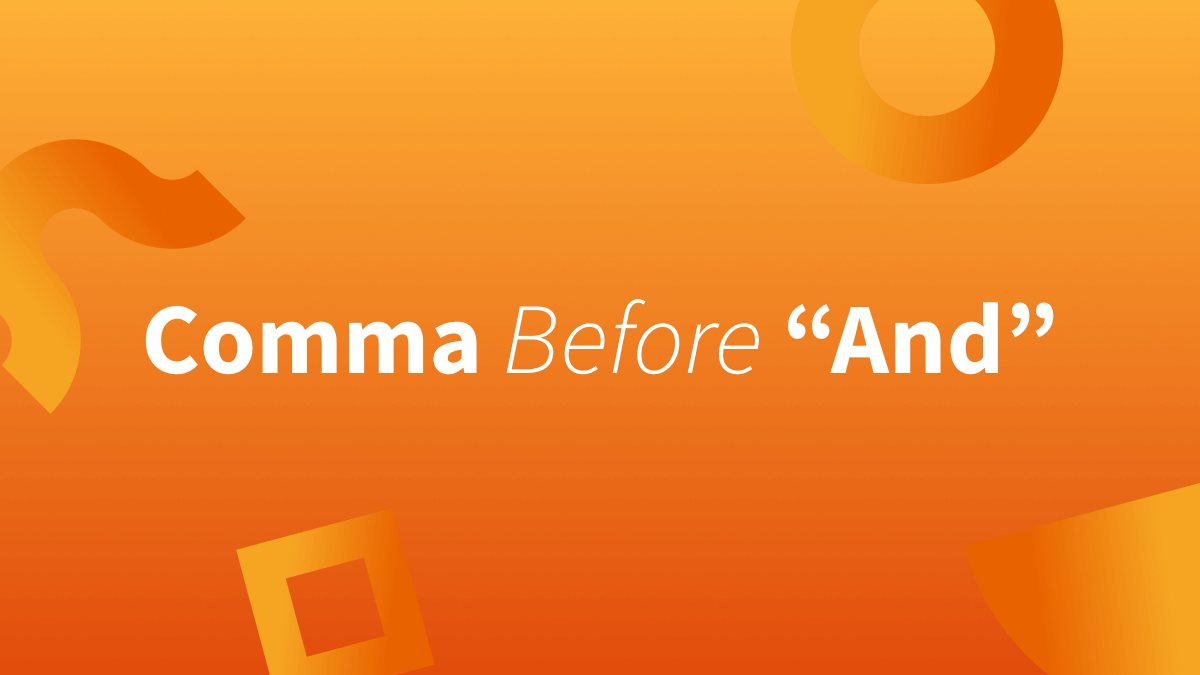Does a Comma Always Precede “And”?

- A comma signals a pause between parts of a sentence.
- When writing a list of three or more, the use of an Oxford comma before and is optional, but often recommended.
- When and connects two independent clauses, a comma should be placed before it.
- The only time a comma isn’t required before and is if the two independent clauses are short and closely related or when a list contains only two entities.
✅ They visited Portugal, Spain, and France.
✅ They visited Portugal, Spain and France.
✅ Catalina stayed with her uncle, and her cousin Ramon stayed with his cousin.
✅ Carlos danced and Felipe sang.
✅ I like bananas and pears.
Is a Comma Before “And” Necessary?
A comma is a punctuation mark that indicates a slight pause between different parts of a sentence. In writing, it helps readers differentiate the clauses. There are many guidelines to keep in mind when deciding whether to use a comma.
Below, we’ll focus and elaborate on when to use a comma before the conjunction and. You can also use LanguageTool's Grammar Checker to ensure your sentences are free of punctuation errors.
A playful parody that includes one of our favorite punctuations—commas.
When To Use a Comma Before “And”
A conjunction is a word that connects words, phrases, and clauses to each other. And is a type of coordinating conjunction (along with for, nor, but, or, yet, and so). Another term you should be familiar with to understand when you should (or shouldn’t) use a comma before and is independent clauses. These are clauses that can stand on their own as grammatically complete sentences. When the conjunction and connects two independent clauses, then a comma is required. For example:
Isaac went to the supermarket to buy food, and then he passed by his dad’s house to have dinner.
In the example above, the two clauses that can stand on their own are:
- Isaac went to the supermarket to buy food.
- Then he passed by his dad’s house to have dinner.
Because they can stand on their own as complete sentences, a comma should be placed before the conjunction and. Here’s another example:
Shawna had to drive all the way back to her house, and Geoffrey had to drop off her cat at the vet.
Shawna had to drive all the way back to her house and Geoffrey had to drop off her cat at the vet.
However, if two independent clauses are short and closely related, then a comma before and isn’t needed. It’s a stylistic choice that’s left up to the writer.
I swept and Thomas mopped.
I swept, and Thomas mopped.
But if and connects an independent clause to a dependent clause, then you shouldn’t add a comma.
My hamster is cute and eats a lot.
My hamster is cute, and eats a lot.
How About Commas Before “And” in Lists?
There are two schools of thought when it comes to using a comma before and in a list: you either love them or hate them. This comma is known as the Oxford, Harvard, or serial comma.
Here’s an example of an Oxford comma before and:
Eduard enjoyed reading about biology, astronomy, and chemistry.
And here is the same sentence without the comma before and:
Eduard enjoyed reading about biology, astronomy and chemistry.
Different publications have their own guidelines when it comes to whether a comma has to precede the conjunction and. If you’re not sure, just ask. If you’re writing for yourself, stay consistent; pick a style and stick with it.
It’s important to note that a list with only two items (or any other type of words) does not require a comma.
She ate pasta and garlic rolls.
She ate pasta, and garlic rolls.
LanguageTool and Commas: A Match Made in Heaven
Commas significantly improve the flow of your writing. The rules mentioned above are just some of the many to remember. If you want to make sure you are always using commas correctly, try out LanguageTool. As a writing assistant, LanguageTool detects missing commas and suggests where you can add them. As if that weren’t helpful enough, this text editor can also correct spelling mistakes and grammar errors in more than twenty languages!
